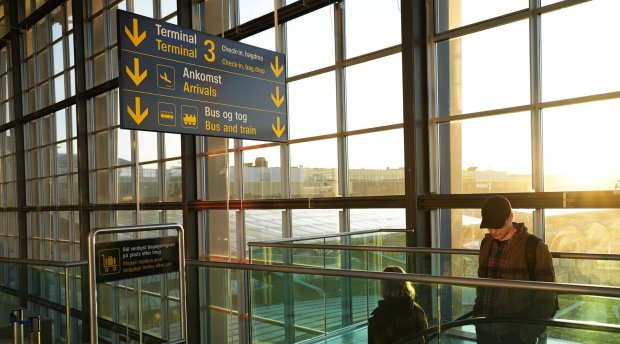CPH interim report: Airport close to break-even thanks to busy spring season

Copenhagen Airport is getting closer to its old self. Eight out of ten passengers are back, and the company has recruited 500 new employees. Following several quarters of losses, CPH turned a profit in the second quarter this year, bringing the first-half year result for 2022 to a slight loss of DKK 12 million before tax. However, there is no denying that inflation, war, new COVID-19 variants, and general global uncertainty continues to be a challenge.
Things are improving at Copenhagen Airport (CPH). Monthly passenger numbers trebled in the first six months of 2022, from 821,000 travellers in January to almost 2.3 million in June. A total of 9.4 million passengers have passed through the terminals at Copenhagen Airport during the first half of 2022.
“The airport has begun to look like its old self during early summer with daily passenger figures of 70,000 to 85,000 and 600 to 700 departures and arrivals on 240 routes. We can tell from both our operations and our books that there is a pent-up appetite for travel whether for leisure or business,” says Thomas Woldbye, CEO of Copenhagen Airport.
Revenue for the second quarter landed at DKK 972 million, a 276% improvement on the same period of 2021. Revenue for the first six months of 2022 was DKK 1,550 million, but still 26% less than for the same period of 2019, the last ordinary year pre-COVID.
The sharp rise in activity during the spring produced a profit before tax of DKK 159 million for the second quarter. Combined with the loss before tax of DKK 171 million for the first quarter, the overall result for the first half of the year ended with a slight loss of DKK 12 million before tax.
“Copenhagen Airport is now very close to its financial break-even point. This is great news after the worst crisis ever for the airport, but we are not out of the woods yet, and unfortunately break-even does not allow us to invest in the future” says Thomas Woldbye.
Confident about the future despite growing debt
Since the crisis hit in March 2020, CPH has borrowed a total of DKK 2.2 billion to keep the airport running and to make the necessary investments.
“Our debt burden poses a challenge to our ability to invest in the sustainable airport of the future and to retain our position as an important northern European air traffic hub. Having that position has historically given Denmark much better connections to the world than the size of our country would otherwise justify – it is a position that supports growth and jobs,” explains Thomas Woldbye.
That is why CPH wishes to amend the regulatory model underlying the charges agreement between Copenhagen Airport and the airlines, to address the heavy losses, significantly increased business risk and debt accumulation during the COVID-19 pandemic.
“We need to bring down and eventually repay the excess debt accumulation, but it is important that we also have the financial strength to invest. We are confident about the future, and we are developing the airport to accommodate the needs of the future. Regardless of the crisis, we need to continue our ambitious project to extend the airside terminal area, for example to create extra space for the baggage reclaim area, for airport travellers, and passport control,” explains Thomas Woldbye.
500 new employees and shorter waiting times
Our recruitment drive illustrates our confidence in the future. During the crisis, CPH had to eliminate more than 800 jobs. Since the turn of the year, on the other hand, the company has been very busy recruiting primarily security staff, filling some 340 positions.
“It has taken some time to train such a large contingent of new staff, but we have done it and we were ready for the busy summer period,” says Thomas Woldbye.
During the first half of 2022, Copenhagen Airports A/S hired a total of 507 new staff.
In total, up to 1,000 companies operate in and around the airport. At the peak of the crisis in 2021, staff numbers of those companies had dwindled from 22,000 pre-COVID to only 13,000. At the beginning of the summer, total headcount was 15,000 and rising.
“Copenhagen Airport is still the setting of one of Denmark’s largest financial ecosystems, with a value creation and financial impact well beyond our own boundaries, and it is essential that the process gathers momentum, so activity at the airport will recover and we can restore job creation,” says Thomas Woldbye.
Still turbulence ahead for aviation industry
The start to the summer season showed that Danes – and Europeans in general – have a strong urge to travel, but it has clearly been difficult for many airports and airlines to keep up with demand and to recruit staff.
“While traffic in Europe is almost back to normal, the recovery is more sluggish on long-haul intercontinental routes – particularly to China and the rest of Asia. The long-haul routes play an important role supporting our position as a hub, because many passengers make their way to their final destinations via Copenhagen. Winning back that traffic is very important to us,” says Thomas Woldbye.
Passenger numbers trebled during the first half of 2022, from 656,000 travellers in January to 1.9 million in June on the European routes – that number is equal to index 79 relative to 2019. During the same period, passenger volumes on the long-haul intercontinental routes grew from 102,000 to 200,000, equal to index 58.
Strikes at SAS and persistent global uncertainty
At Copenhagen Airport, the strike in July by SAS pilots and aviation mechanics will impact passenger numbers during the summer period. On 5 July, the SAS management filed for Chapter 11 protection in the USA with a view to restructure the company.
“Obviously, we are monitoring the situation very closely. We have partnered with SAS for many years and it is still the largest airline at Copenhagen Airport, accounting for almost one third of traffic. Moreover, SAS is the main airline supporting the hub status that is so very important to Denmark,” explains Thomas Woldbye.
The volume of European air traffic is expected to grow compared with 2021, but developments for the rest of the year remain highly uncertain due to the risk of new, highly infectious COVID-19 variants, the war in Ukraine, the growing rate of inflation and with it, rising prices of energy and fuel.
As a result, it is still not possible to provide a reasonably realistic and comprehensive assessment of the financial outlook for CPH in 2022. CPH will continue to monitor the situation very closely and will assess and adjust operating costs and the level of investments on an ongoing basis. CPH will keep the market updated when it becomes possible to provide a more precise financial outlook.


